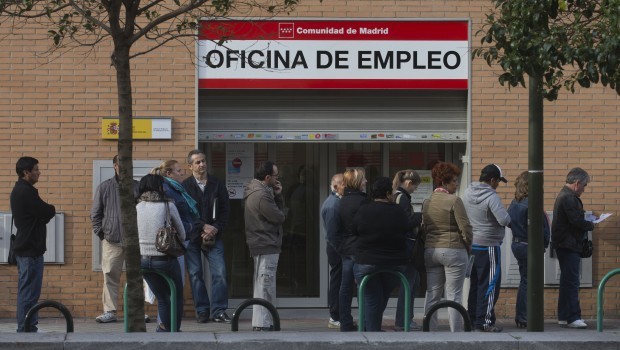
People queue outside an unemployment registry office in Madrid, Spain, in this file photo dated Monday May 6, 2013. (AP Photo/Paul White)
Madrid, AP—Minube, a travel startup on the outskirts of Madrid, is doing something that many Spanish companies haven’t thought about for years: It’s hiring.
The company, which sells bookings as it helps travelers share their experiences using social media, has nearly doubled its headcount from 17 at the end of last year to 30. Business is booming as customers come in from across Europe—including some places hardest hit by Europe’s economic crisis.
“We’re finally starting to see a bigger growth curve in Spain, and the strong growth in Italy has been a surprise,” Minube’s co-founder, Pedro Jareno, said. “The improvements we are starting to see in the market are constant.”
That brighter—or less gloomy—backdrop was confirmed in figures Wednesday, which showed that the longest-ever recession to afflict the eurozone came to an end in the second quarter of the year.
Eurostat, the European Union’s statistics office, said the 17 EU countries that use the euro saw their collective economic output increase by 0.3 percent in the April to June period from the previous quarter.
That’s the first quarterly growth since the eurozone slipped into recession in the last three months of 2011. The ensuing recession of six quarters was the longest since the euro currency was launched in 1999.
The improvement made up for the previous quarter’s equivalent decline and was moderately better than the 0.2 percent anticipated in the markets. Growth, however anemic, had been predicted by many economists following an easing in market concerns over Europe’s debt crisis over the past year and record low interest rates from the European Central Bank.
The eurozone’s growth, which translates to an annualized rate of about 1.3 percent, is still well below the 1.8 percent the US enjoyed during the second quarter. The wider 27-country EU, which includes non-euro countries such as Britain and Poland, also emerged from its own, milder recession, and like the eurozone is also growing at an annualized rate of around 1.3 percent.
Growth in Europe provides a boon to the global economy. The EU, which now totals 28 following Croatia’s accession in July, has a population of around 550 million and its annual gross domestic product stands at around USD 17.3 trillion—both more than the US, which has GDP of USD 16.6 billion for 315 million people.
The EU’s recovery marks the first time since a brief period in 2011 that the four major pillars of the world economy—the US, China, Japan and Europe—are growing at the same time.
The figures will be greeted with a sigh of relief by Europe’s policymakers, who have spent nearly four years grappling with a debt crisis that has threatened the very future of the euro. But they were not ready to declare victory, aware that this is only the start of what is expected to be a slow and uneven recovery.
“This slightly more positive data is welcome—but there is no room for any complacency whatsoever,” Olli Rehn, the EU’s top monetary official, said in his blog after the release of the figures. “I hope there will be no premature, self-congratulatory statements suggesting ‘the crisis is over’.”
The improvement was largely due to solid growth of 0.7 percent in Germany and a surprisingly strong 0.5 percent bounce-back in France following two quarters of negative growth.
Aside from Europe’s top two economies, there were signs of stabilization elsewhere, notably in Portugal, which expanded by a surprising 1.1 percent. Spain and Italy saw the pace of their economic contractions slow.
There was even evidence that the recession in Greece, the country at the heart of Europe’s debt crisis, is easing, too. Eurostat doesn’t publish quarterly figures for Greece. It only has annual comparisons and they showed that the year-on-year contraction eased to 4.6 percent in the second quarter from 5.6 percent in the first.
Major European companies have benefited from the more stable economy. ArcelorMittal, the world’s largest steelmaker, says the worst is over and that European demand is finally on the rise again. Many companies, however, are still relying on foreign markets to drive profits. Big exporters, like German car maker BMW, are selling a lot in China and pushing into fast-growing emerging markets.
The recovery in Europe, the world’s largest trading bloc, is expected to cause an increase in global trade levels later this year as exporters like Germany gather pace and Europeans buy more products from companies in the US, Japan and elsewhere.
Despite that cautious note of optimism, analysts said the eurozone still has a long way to go before it can say it has proved the skeptics wrong. Europe’s indebted governments still face years of spending cuts and tax increases and many, notably Greece and Spain, are weighed down by record-high unemployment of over 25 percent. A full recovery across the eurozone is not expected before 2015.
“While the return to economic growth in the eurozone is a welcome development, it would be wrong to think that it will bring an end to the travails of the highly indebted and uncompetitive countries of the periphery,” said Jonathan Loynes, chief European economist at Capital Economics. “The recession may be over, but the debt crisis is decidedly not.”
For many people in Europe, even a mild improvement is cause to celebrate—and a suggestion that the darkest days are in the past.
When Jareno co-founded Minube in 2007, the global credit crunch was just about to erupt. That sent Europe into a recession that was shorter but deeper than the current one, and prevented Minube from getting bank loans to expand.
In the past year, visits to his website have increased by two-thirds and commissions on booked trips have jumped 300 percent.
“Figures have only gone up,” Jareno said, “and that might be a sign that trust has improved.”
